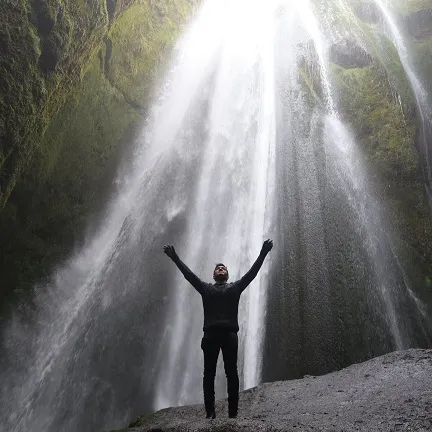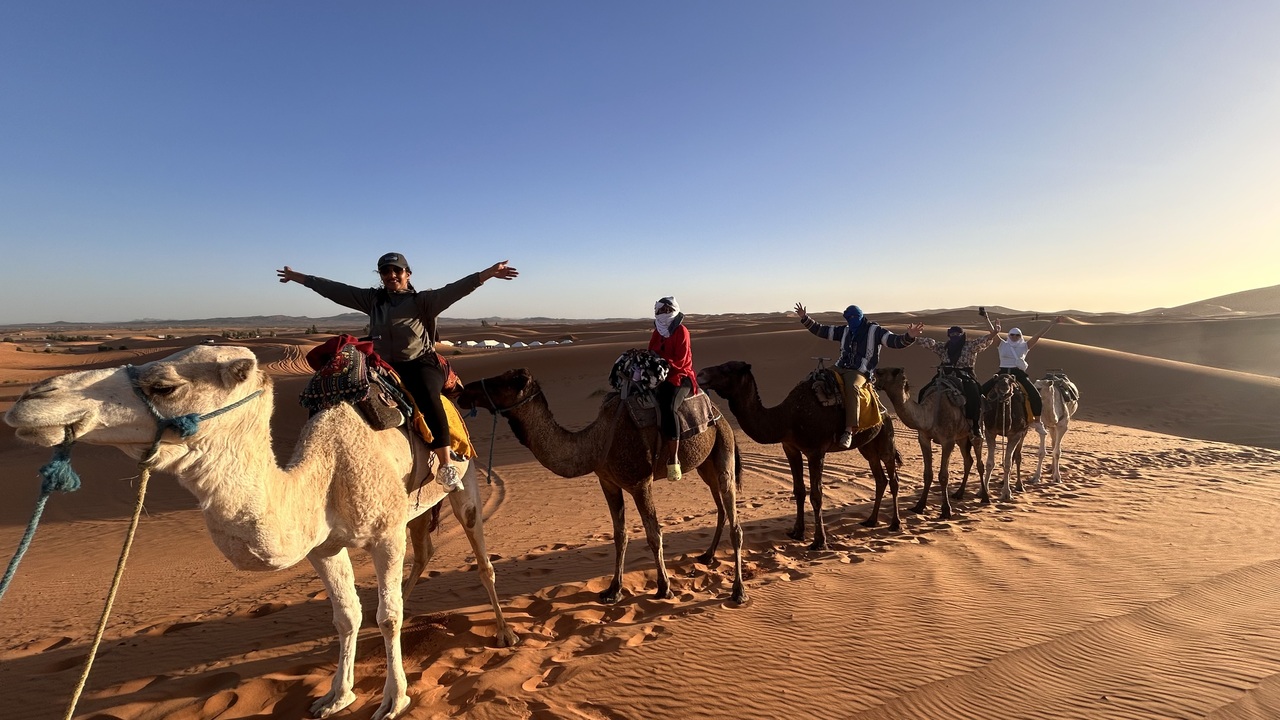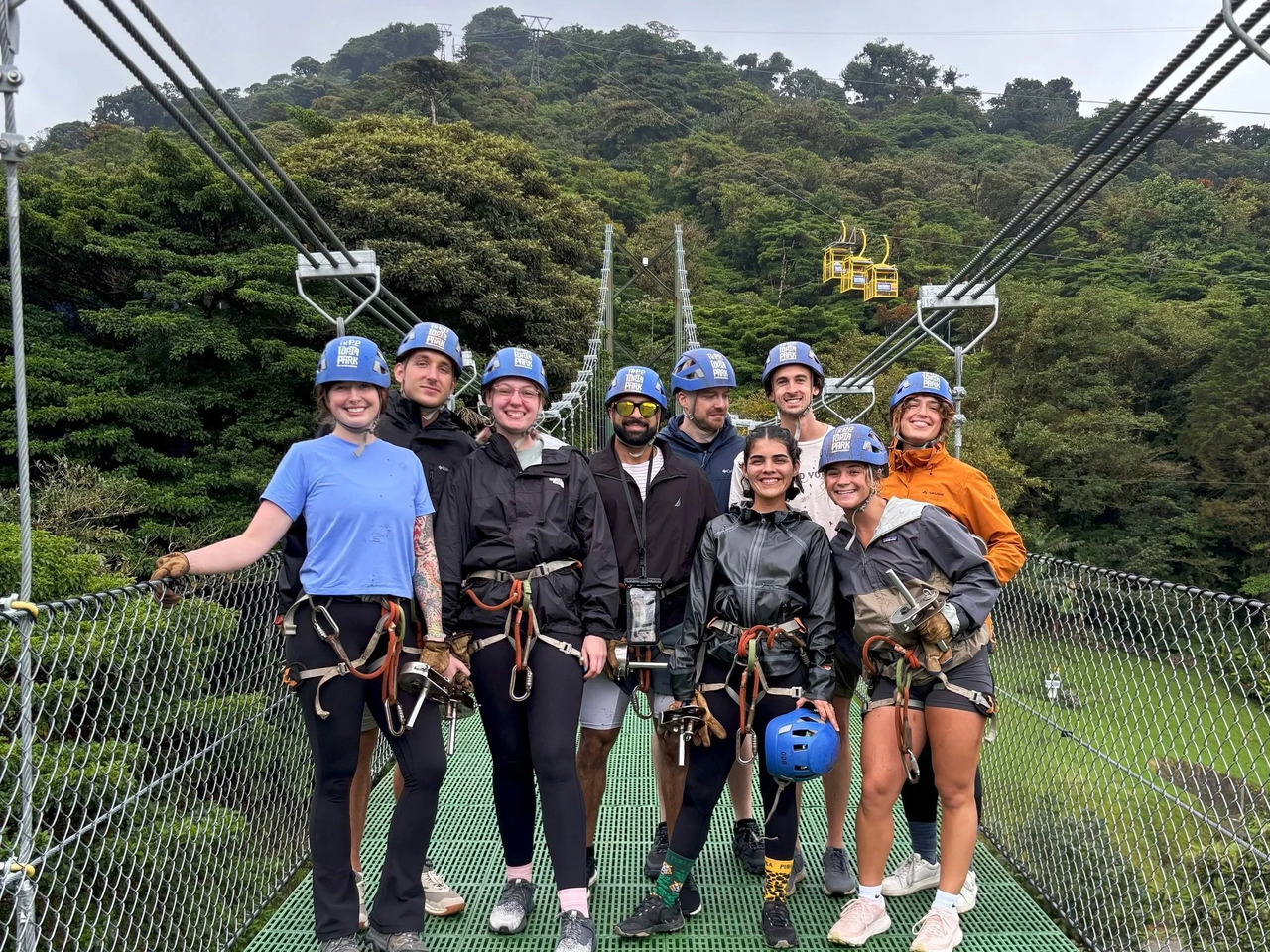Quepos and Manuel Antonio, Costa Rica are a paradise for solo travelers. I spent more than five years living here, where the jungle meets the Pacific Ocean. It’s absolutely my favorite place in Costa Rica. This area offers some of the best beaches in the world, wildlife, Manuel Antonio National Park, an authentic Costa Rican town, mountains, waterfalls, sportfishing, and whitewater rafting, all within a thirty-minute drive.

What this solo travel guide covers:
- Quepos, Costa Rica
- Manuel Antonio, Costa Rica
- Best places to eat and drink
- Los Campesinos, Nauyaca, and other waterfalls near Manuel Antonio
- Dominical, Costa Rica
If you are looking to explore other regions of Costa Rica, check out my Ultimate Solo Travel Guide to Costa Rica.
Best time to visit: The driest weather is between November 15 and April 15. Expect temperatures to be around 85 degrees Fahrenheit during the day and in the 70s at night. The sun is very strong midday, so wear sun protection!
November and April can be considered “shoulder season” where you’ll find fewer crowds both before Thanksgiving and after Easter. It can rain at this time of year, but this transition season can be a very nice time of year to travel.
April 15-November 15 is considered the rainy season, or cleverly branded as “green season”. Prices are cheaper, and there are no crowds. Expect a mix of clouds, rain, and occasional sun. Here is why you should visit Costa Rica during rainy season.
Safety: Overall, this region is pretty safe, but don’t walk alone at night or leave your stuff unattended at the beach. Petty theft can be an issue in the area. Take caution in the town of Quepos, especially after dark. Don’t go to the beach at night. Keep your valuables locked up in the hotel, and not unattended in a rental car.
Quick 3-day Itinerary: Get up as early as possible in the morning to visit the Manuel Antonio National Park. Relax on one of the hidden beaches in the afternoon, and exit the park for lunch at Cafe Milagro. Take surf lessons in the afternoon and see an incredible sunset.
The next day, rappel down a waterfall with Quepo Canyoning. Visit the Farmer’s Market (La Feria) on a Friday night.
On your last day, enjoy some beach time and then take a cruise on the Pacific Ocean and see bottlenose dolphins for sunset. Eat at Emilio's Cafe for dinner.

Where to Stay in Manuel Antonio, Costa Rica
- Hostel: Selina’s. If you want to interact with other travelers, this is your place to go. They have nightlife around the pool, a wellness program with yoga classes, and a co-working space if you need to get work done. Dorms and bungalows are available.
- 3-star: Costa Verde. Stay in a Boeing 727! This is a very nice three-star hotel. They have the best yoga platform in Manuel Antonio and beautiful pools.
- 4-star Boutique: La Issimo. This hotel features an incredible view of the Pacific Ocean and is within walking distance of a tiny beach called Biesanz.
- Most Unique: El Faro Containers Beach Hotel. Offers a great view near Manuel Antonio National Park, where you’ll stay in rooms made out of old shipping containers.
- Most Sustainable: Si Como No. For a true eco-tourism experience, stay with one of Costa Rica’s leaders in sustainable hospitality, owned by a small company called Greentique. Visit the wildlife sanctuary they run across the street. Si Como No uses biodegradable cleaning products, composts food waste, and supports local schools.
- Honorable Mention: Teva. I’d describe this place as a hostel/hotel hybrid, offering brand new budget rooms, dorm options, and a nice outdoor space to hang out around the pool, including a short nature walk. This place has had a few big parties, but I’m not sure if that is still the vibe.

How to get to Manuel Antonio, Costa Rica
The closest international airport to Manuel Antonio, Costa Rica is Juan Santamaría International Airport (SJO), in Alajuela, Costa Rica, just outside of San José. If you need trusted private transportation to Quepos, I recommend the locally owned Pacifico Transporte. Expect to pay around $150 USD for a private car.
During the dry season, taking a domestic flight with Sansa on a Cessna aircraft can be a fun experience, if you like small planes. Flying from SJO to the landing strip in Quepos takes about 30 minutes and fares can cost around $100 USD.
Taking the public bus from the SJO to Quepos is complicated. You need to take the bus from in front of the airport to the center of San José, then a taxi to the Tracopa Bus Station. Do not walk, as this area is dangerous. Then, take the Tracopa Bus to Quepos. This whole ordeal should cost around $15 USD and take 4-5 hours.
To go from Quepos to the airport is much easier. Just take the “Collectivo” Tracopa bus from Quepos to the airport. Expect to pay around $10 USD and take 4 hours.
If you wish to rent a car, there are many options at the airport near San José. Keep in mind that the roads are windy and not well marked. I suggest having an overseas wireless internet plan to be able to access a navigation app on your phone. Waze is the app that Costa Ricans use.
How to get around Manuel Antonio, Costa Rica
- Public Bus: the bus runs every twenty minutes between the center of Quepos and the National Park. It costs around 315 colones to ride (about 50 cents). The driver gives change and accepts US dollars. Ask locals where the bus stops are, as they are not well marked.
- Rental Car: If you must rent a car in the area, I’d suggest leaving it at your Airbnb or hotel and riding the bus around town as parking is often difficult. If you want to rent a car for a day trip, my choice is always Economy in Manuel Antonio.
- Taxi: Uber doesn’t work well here, and the taxis are notorious for ripping people off. Agree on a price before you get in. Your ride should range from 2,000-5,000 colones. They will pick you up if you call +506 2777-7380.
- Collectivo: I wouldn’t ever suggest riding “collectivo” to our travelers, but if you are tempted to jump into one of the cars that drive up and down the road picking up random people for $1 USD, please be careful. Bad actors will sometimes pose as collectivo drivers and rob people who get in. Look for women and children inside if you are going to ride.

What/Where to Eat and Drink
- Café Milagro: This is the cutest restaurant in town, and they always deliver the best service. The food is great, and their coffee has won numerous awards. If you are going to buy Costa Rican coffee to bring home this is where to purchase it. I always ate the fish of the day or the fish tacos. Stop in for live music at night on the patio.
- Emilio’s Café: Go to Emilio’s for lunch, so you can see the beautiful view overlooking the Pacific Ocean. Their coffee is also quite good.
- Soda Tiquicia or Soda Sánchez: For local flavor, try to go out at least once in the town of Quepos. If you are on a budget, try to eat as many meals as you can at the local “soda” (small restaurant). La Tiquicia has a nice atmosphere and is a very typical Costa Rican restaurant. Soda Sanchez is my favorite hole in the wall. Get a “casado”, which is a plate of rice, beans, with your choice of protein, a tortilla, Costa Rican sour cream, and fried plantains. If you go for breakfast, “gallo pinto”, rice and beans served with eggs and a tortilla is mandatory.
- El Ángel: This is my favorite “soda” in Manuel Antonio. It’s family-owned, and I always order either the fish casado or “chuleta” which is pork chop.
- Where to get the best ceviche: If you didn’t know that ceviche is fish cured in citrus, now you do. It’s usually served with plantain chips or rice, and the best place to get this is in the central market of Quepos. The market isn’t anything to write home about, but if you speak Spanish, it’s a fun place to sit and listen in on conversations about soccer or local politics.
- El Avión: Undoubtedly you’ll see a giant 747 airplane sitting on the side of the main road through Manuel Antonio. Go for happy hour and have a drink. It’s right across from Selina’s Hostel.
- Nightlife: Nightlife can be hit or miss in Quepos and Manuel Antonio, so it’s best to ask around. During peak season, things tend to pick up. Selina’s usually has something going on, and if you decide to go to Quepos at night, please be careful at places like Republik and Bahia Azul.

Top Things to Do in Manuel Antonio, Costa Rica
- Hang out at the beach: Tripadvisor has ranked Manuel Antonio as one of the top fifteen beaches in the world, so you’ll certainly want to spend some time at the beach. My favorite areas are at either end of the beach, as they have beautiful rock outcroppings and are less crowded. I try to avoid the main beach “Playa Espadilla” if I can because there are a lot more tourists. Walk from Café Milagro down to Playitas if you can. There are great hidden beaches in Manuel Antonio National Park, and Playa Biesanz is usually off the beaten path, except during peak season. If you park at the beach, be prepared to pay a few dollars to a local to watch your car.
- Dolphin and whale watching: If you come from August to October it’s a great time to see humpback whales. It can be quite rainy during this time, and many businesses go on vacation during October, but it is the best time to see whales. You’ll have the opportunity to see bottlenose, spinners, and spotted dolphins throughout the year. Tours with Planet Dolphin and Ocean King leave from Marina Pez Vela. Expect to pay around $75 USD for a day trip.
- Sportfishing: This is an expensive endeavor, but some of the best sportfishing in the world is off the coast of Quepos, Costa Rica. Marlin and sailfish are the big catches, but you can also get dorado, yellowfin tuna, and plenty of other fish offshore. There are lots of charters here offering trips out of Marina Pez Vela. Expect to pay around $800-$1000 USD for your group to go out on the ocean.
- Manuel Antonio National Park: I have mixed emotions about the National Park. Before COVID-19 it was a prime example of overtourism and many practices were not sustainable. It felt more like a zoo than a National Park. After COVID, things have changed, and the government has addressed several sustainability issues. It’s still the best place to see sloths and monkeys. Please do not feed the animals in Costa Rica. Expect to pay around $16 USD.
- Canyoning: I’d rate Quepo Canyoning as the most unique activity in this area of Costa Rica. Go deep into the jungle with excellent guides for a really fun trip that ends with you rappelling down a waterfall, and doing a famous “monkey drop” into the lagoon. Expect to pay around $80 USD.
- Waterfalls: If you are going to Costa Rica, you need to make a point to add a waterfall to your itinerary. Lucky for you, there are nearly a dozen waterfalls within an hour’s drive of Manuel Antonio. I’d suggest Los Campesinos, Eco Chontales, La Ceiba, Nauyaca, Uvita, Pavon, and Ojochal, all of which you can *probably* find on Google Maps and four-wheel drive, but your mileage may vary. If you want to be safe, go with my friends at Paddle 9. Expect to pay $145 USD.

- Day trip to Dominical: I cover Dominical more extensively in my Guide to Costa Rica, but if you are looking for a fun little beach town to explore, Dominical is a great pick. Visit the hippie market, natural foods store, Café Mono Congo, and surf! Ride the bus from the center of Quepos. If you need a unique souvenir, take home some VIDA Blue Rainforest Clay for your beauty routine. Dominical is a 45-minute drive from Quepos.
- Chocolate Tour with Mamá Cacao: Lots of cacao is grown in Costa Rica and there is nobody better to show you how it goes from tree to bar than my friend Mamá Cacao. Contact her for a chocolate tasting, workshop, or to take some home!
- Hiking in Manuel Antonio: There are a lot of beautiful hiking trails in Manuel Antonio National Park, and they are all well-marked. My favorite is Punta Catedral. Park entrance is around $16 USD and reservations are currently required. For an off-the-beaten-path, not well-marked hike, ask around about the condition of the Reto M.A.E. trail. MAE stands for “Manuel Antonio Extreme”, so this is for advanced hikers only.

- Mangrove Tour: If you want a real look at small-town Costa Rica, plus an opportunity to see wildlife, consider going up the estuary in Quepos with Safari Adventures. If you go on a Saturday or Sunday, you’ll see all the locals fishing and hanging out on the banks of the estuary. To me, this tour gives you a true Central American feel, where Marina Pez Vela feels more like Fort Lauderdale.
- Whitewater Rafting: Quepos is a great starting place for whitewater rafting trips. Depending on the season and water levels, the Naranjo and Savegre River host rapids up to class V. For the most adventurous, go through the famous “Chorro” section. I’d recommend going with Leo from H2O Adventures. Expect to pay around $130 USD.
- Surfing: There are several beach breaks in Manuel Antonio. The main beach at Playa Espadilla is a good place to learn with my friend Marco--ask around, everyone knows him. You can also learn at what the locals call Karahé with Blue Horizon, or go rip the advanced wave all the way down the beach at Playitas. A board rental should be around $20 USD and a lesson is more like $60 USD. Feel free to negotiate.

- Fitness: If you are trying to stay jacked and tan, I need to direct you to a few of my favorite places to work out. The best local gym experience is definitely Muchó Músclo. It’s $5 USD for a guest pass. If you are a Crossfitter, drop into a class at Quepos X-fit, and if you’d like kickboxing instruction, ask for Mario. For yoga and massage, visit Spa Holis and ask for Lorenzo to drop into a Brazilian Jiujitsu class.
Looking to extend your trip through Central America? Check out my Guide to Mexico, Central America, & the Caribbean! For even more, check out The Millennial Travel Guidebook: Escape More, Spend Less, & Make Travel a Priority in Your Life.




.avif)


























